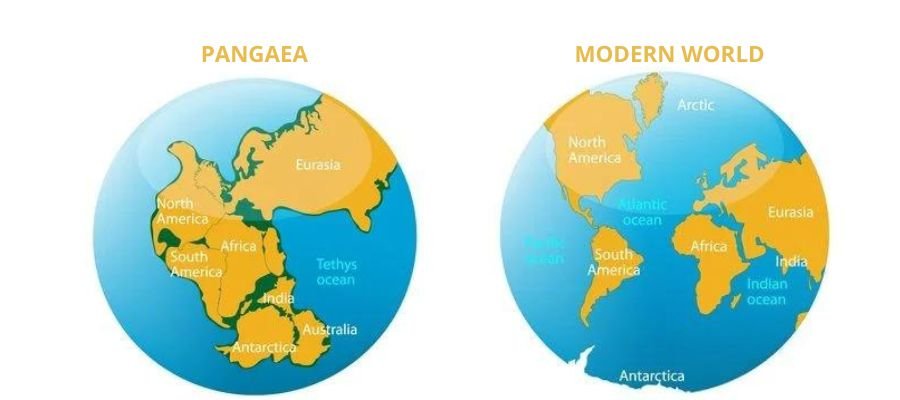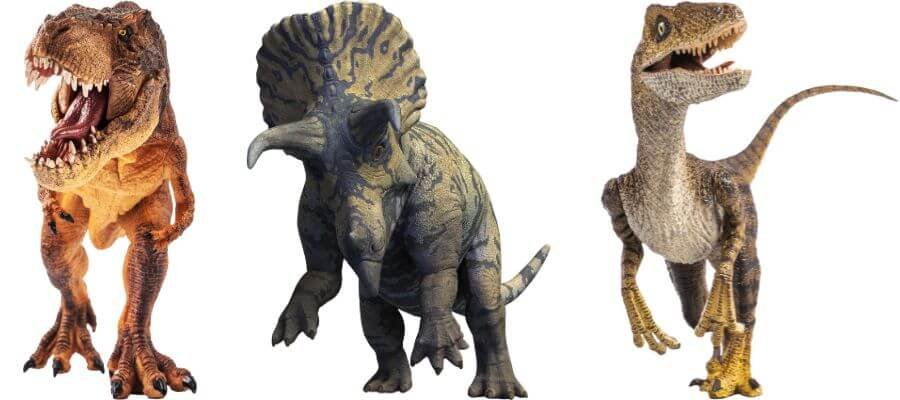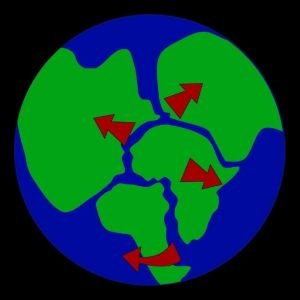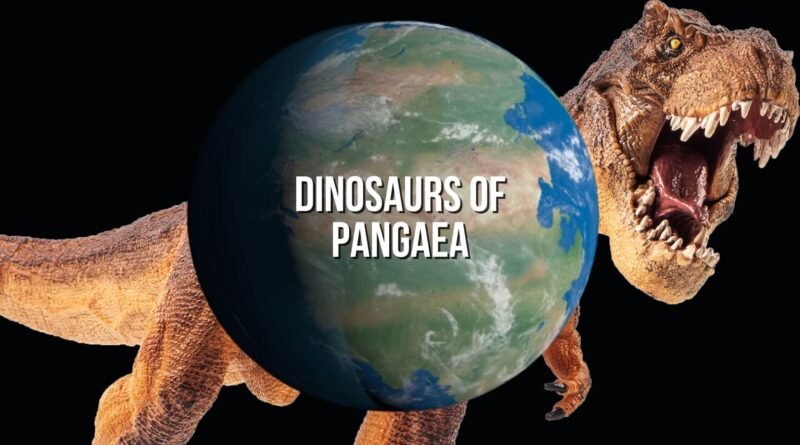Dinosaurs of Pangaea: An Age of Giants
Welcome to a fascinating journey through Earth’s distant past, where a giant reigned supreme: Pangaea. This supercontinent, formed about 335 million years ago, has witnessed the emergence and evolution of magnificent creatures that have dominated the landscape for millions of years. Over the course of approximately 160 million years, Pangaea shaped the course of life on Earth before splitting into the familiar continents we know today.
In this article, we will explore not only the history and durability of Pangaea, but also delve into the amazing variety of dinosaurs that called this vast territory home. Get ready for a journey back in time as we unravel the mysteries and wonders of Pangaea and the fascinating creatures that once inhabited it.

Theory of Continental Drift
Pangaea was one of the supercontinents that arose on the planet. The theory of continental drift, proposed by the German scientist Alfred Wegener in the early twentieth century, suggests that the continents of the Earth are not fixed in their current positions, but rather that they were once united into a single supercontinent and moved over geological time. The central idea of the theory of continental drift is that the continents were originally grouped into a supercontinent called Pangaea, which began to fragment and move in different directions.
The name “Pangaea” has etymological origins in Greek. It is derived from the Greek word “pan”, which means “all”, and “Gaea”, which refers to the Earth or land. Therefore, “Pangaea” can be roughly translated as “all Earth” or “all land”.
Wegener proposed this theory based on various evidence, including:
1. Adjustment of Coastal contours
The contours of the coasts of the continents seem to fit together impressively, as if they had already been united.
2. Distribution of fossils
Some fossils of plants and animals were found on continents separated by large oceans, which indicated that these regions were once connected.
3. Similar mountain ranges
Certain mountain ranges on different continents, such as the Appalachian Mountains in North America and the Caledonian Mountains in Europe, appeared to have similar geological features.
4. Stratification patterns
Geological patterns, such as rocks and stratifications, showed similarities between different continents.
Although Wegener proposed this theory, the explanation for the mechanism behind it was only provided later with the development of the plate tectonic theory. According to this theory, the Earth’s lithosphere is divided into tectonic plates that float above the asthenosphere and are in constant motion. Continental drift is now understood as a component of the broader process of tectonic plates movement.
Tectonic plates
The theory of continental drift helps explain the existence of Pangaea. According to this theory, the continents were once united in a supercontinent called Pangaea, and over geological time they separated and moved to their current positions on the Earth’s surface. Pangaea would have begun to form during the late Carboniferous and Early Permian periods, about 335 million years ago.
The explanation provided by the theory of continental drift is that the tectonic plates, which make up the Earth’s crust, are constantly in motion due to processes in the Earth’s mantle. In this context, Pangaea would be the result of the collision and fusion of smaller land masses, and the subsequent separation of the continents would be due to the continuous movement of the plates.
Therefore, the theory of continental drift, together with the plate tectonics theory, offers a more comprehensive understanding of how continents move over geological time, explaining the formation and fragmentation of Pangaea. The plate tectonics theory is more recent and more comprehensive.
Dinosaurs of Pangaea
Pangaea, which was a supercontinent, a landmass that existed during the Paleozoic and Mesozoic eras, approximately between 335 million and 175 million years ago, was forming and subsequently fragmenting as diverse dinosaurs inhabited the Earth. Pangaea existed for approximately 160 million years.
During the Mesozoic period, which spans about 180 million to 65 million years ago, dinosaurs dominated the Earth. They have evolved and diversified over these millions of years. While Pangaea still existed, different groups of dinosaurs inhabited different parts of the supercontinent.
During the period in which Pangaea existed, known as the Mesozoic period, which stretches from the Triassic to the Cretaceous, a wide variety of dinosaurs inhabited the Earth. We will provide some representative examples of dinosaurs from each of the three main divisions of the Mesozoic:
1. Triassic (about 252 to 201 million years ago):

• Eoraptor: One of the first known dinosaurs, small and bipedal.
• Herrerasaurus: Another dinosaur of the Early Triassic, carnivorous and bipedal.
2. Jurassic (about 201 to 145 million years ago):

• Stegosaurus: A herbivorous dinosaur known for its bony plates along its back.

•Allosaurus: A large and agile theropod carnivore.

• Brachiosaurus: A large long-necked herbivorous dinosaur.
3. Cretaceous (about 145 to 66 million years ago):

• Tyrannosaurus rex: One of the largest theropod carnivores and one of the most famous dinosaurs.
• Triceratops: A herbivore with three distinct horns on its skull.
• Velociraptor: A small carnivorous dinosaur known for its agility.
Supercontinent breakup

As the ancient supercontinent Pangaea began to break apart due to continental drift, it set off a chain of environmental changes that reshaped the distribution and evolution of dinosaurs. This breakup, driven by the movement of Earth’s plates, led to the formation of the continents as we know them today, including South America and the lands across the Northern and Southern hemispheres. With Pangaea’s fragmentation over millions of years ago, distinct climates and habitats emerged, contributing to the diverse evolution of dinosaurs until their mass extinction at the end of the Cretaceous Period, around 65 million years ago. This event is often attributed to catastrophic occurrences like asteroid impacts or significant volcanic eruptions.
The division of Pangaea not only gave rise to the Atlantic and Indian Oceans but also initiated the separation of Africa from South America, creating the South Atlantic Ocean. This process was gradual, occurring in stages and leading to the creation of the Earth’s continents as recognized in the geologic record. The breakup delineated the continental crust, further dividing the planet into the seven continents, including North and South America, and shaped the geological features of the Earth through the Triassic, Jurassic, and Cretaceous periods, as documented by the geological society.
These geological changes, occurring across the geologic time scale, were instrumental in the development of the supercontinent cycle, influencing the planet’s climate, the distribution of terrestrial and marine species, and even the location of glacial deposits. Earth scientists utilize geological evidence, such as the rock record and fossilized remains, to understand these profound shifts in Earth’s history, including the formation of mountain chains and the emergence of new oceans like the Neo Tethys and Paleo Tethys Oceans.
The concept of continental drift explains how the continents we recognize today, from the ancient landmasses like the Indian subcontinent to the vast expanse of the Pacific Ocean, have arrived at their present positions through the movement of Earth’s outer shell, driven by convection currents beneath the surface. This movement has not only separated continents like India from the rest of the landmass but also brought into focus the dynamics of Earth’s climate through different eras, from the Permian period to the present day, showcasing the incredible journey of our planet Earth through geologic time.
Final Thoughts
The theory of continental drift stands as a pivotal breakthrough in our understanding of Earth’s history, illustrating the dynamic movements and evolution of continents over geological time. This theory sheds light on how all the continents, including notable ones like North America and Africa in the Earth’s northern hemisphere, once comprised parts of a massive landmass known as the supercontinent Pangaea. Over time, this colossal mass fractured and its pieces drifted apart, reshaping the planet’s surface across extensive periods.
Scientific research elucidates that the Earth’s crust is segmented into continental plates, which inch across the globe like segments of a vast jigsaw puzzle. These plates, through their interactions, fracture and coalesce, altering the Earth’s facade. It’s been discovered that the origins and separations of continents correlate with movements in the Earth’s mantle beneath its crust.
This continuous transformation underscores that continents and oceans, including those in the southern hemisphere and the southern polar regions, are in a state of perpetual flux. The Atlantic Ocean, for instance, once segmented, now forms a significant cohesive body of water. Such insights are instrumental in understanding the present configuration of the world, epitomized by the breakup of Pangaea into two continents flanking the central Atlantic Ocean during the Triassic period, setting the stage for the evolution of terrestrial species.
The concept of supercontinents, such as the recent supercontinent Pangaea, and their ability to form, break, and occasionally reunite into formations like the predicted next supercontinent, is fundamental to geology. The breakup of Pangaea, which initiated in the late Triassic and continued into the Jurassic, saw the eastern portion of Gondwana (including India) separate, moving through the Paleo Tethys Ocean towards the Neo Tethys Ocean, south of what is now Asia. This mass stretching from the south pole, past the equator, into the northern hemisphere, illustrates the dynamic nature of continental drift, influenced by underlying forces that rotate continents clockwise or counter, shaping the Earth through eons.
Further, the geological survey of rock formations across continents reveals that areas now separated by vast oceans were once connected. Fossils of the same age and type found in South China and the southern polar regions suggest these areas were once adjacent. The continents fit together not just in a physical sense but also in a historical narrative that encompasses climate models, the Tethys Ocean’s evolution, and the distribution of flora and fauna across the globe.
In essence, the study of continental drift and the subsequent movements of the Earth’s plates offer a fascinating window into the past, present, and future of our planet. It underscores the interconnectedness of all continents, from the formation of supercontinents like Pangaea to the present-day continents and the intricate dance of geological forces that continue to shape our world.





